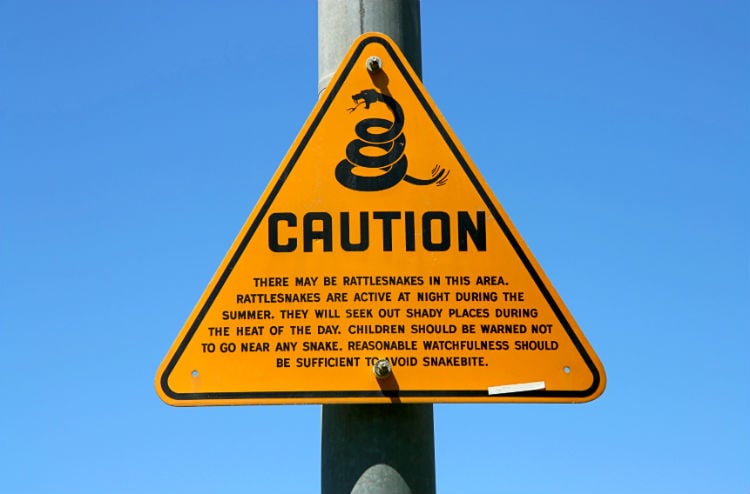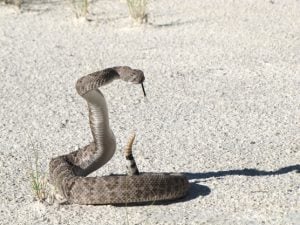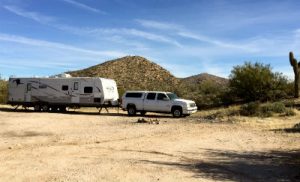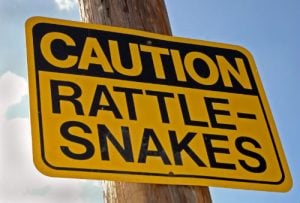Rattlesnakes are a common reptile in the wild and they can be deadly when they strike. In June 2016, a short hike to a local lake turned tragic when a 71-year-old man was killed following a sudden bite from a venomous rattlesnake in the Santee National Wildlife Refuge near Columbia, South Carolina.

Rattlesnakes are known to usually avoid people and human attacks are rare where they inhabit. But they can happen.
According to The Herald, Conservationist Wayne Grooms was hiking with a friend when he was struck by the rattler in his lower left leg. Grooms eventually collapsed and died a mere 15 minutes after the bite, reports the Clarendon County Coroner’s office.

While not all rattlers are venomous, this Western Diamond Back at White Sands National Monument is. Photo courtesy NPS.
While rattlesnakes inhabit various regions in the Southwest, they can also be found in the many winter snowbird destinations in the Southeast, as well as the Northwest and other parts of the country in the warmer months. When visiting a new, unfamiliar area in your RV it’s vital to know if you are in fact in rattlesnake country.
Although rattlesnakes are known to usually avoid people and human attacks are rare, they do happen. If you see or hear the bone-chilling sound of a rattlesnake, avoid it completely and clear the area immediately.
In another instance, from a report in the Pittsburgh Post-Gazette, Russell E. Davis was camping in Beaver County, Pennsylvania in July 2015. He was bitten by a rattlesnake while putting wood on a campfire.

Rattlesnakes inhabit various environments, not just dry, arid conditions. Photo courtesy of Nunyadamn RV2.com member
After alerting his girlfriend, they drove to the hospital when Davis began experiencing severe breathing problems.
When they stopped at a local business for help, an ambulance arrived shortly after and paramedics began CPR. Davis died a short time later of a full cardiac arrest, before arriving by air to a Pittsburgh hospital.
While some bites can be fatal—depending on the species—many are not. According to the U.S. Food and Drug Administration, approximately 8,000 people encounter venomous snake bites every year, with 10 to 15 attacks resulting in death.
In fact, Kirsten Macintyre, Communications Manager for the California Department of Fish and Wildlife, explains 25 percent of rattlesnake bites are dry, meaning no venom injects into the human body.
Be aware of the bite from rattlesnakes.
If you do experience a bite, the U.S Forest Service recommends to:
- Call EMS or seek medical attention immediately.
- Remain still. Movement can spread venom through the body.
- Keep the injured body part motionless to just lower than heart level.
- Stay warm with blankets, jackets, sweaters, etc.
- Don’t eat or drink anything.
- Cover the bite with a clean, dry dressing.

Pay attention to local signs and follow appropriate precautions.
Rattlesnakes are not only in the wild. In September 2014, a 91-year-old man was struck by a rattlesnake while outside of a grocery store in Quartzsite, Arizona. The Havasu News reports he was walking into the building and was bit by an adult Western Diamondback, just above his ankle. The man immediately went to the local hospital where he responded well to treatment.
As many RVers head to winter snowbird destinations in the Southwest or Southeast, they should be aware if rattlesnakes inhabit the area. If they do, The California Department of Fish and Wildlife recommends:
- Never go barefoot in the wild. Wear boots over the ankles and long, loose-fitting pants. Avoid tall grass, weeds and heavy underbrush where snakes rest during the day.
- Be careful climbing rocks or gathering firewood. Always shake out sleeping bags before use.
- Don’t grab sticks or branches in lakes and rivers. Rattlesnakes can swim.
- Always have someone in the outdoors with you who can assist in an emergency.
- Never handle a freshly killed snake as it can still inject venom.
- Teach children to leave them alone.
“Rattlesnakes are generally not aggressive unless threatened or provoked, ” Macintyre told RV Life. “When they have enough room, they will retreat.”
Know the dangers of rattlesnakes
Nonetheless, in the event of a bite, which can happen in mere seconds, the symptoms of the venom develop soon after.
“The impact of venom depends on a number of factors, including the size of the person and their heart rate,” says Macintyre. “Symptoms of a severe bite are extreme pain and swelling at the location of the bite, excessive bleeding, nausea, diarrhea, swelling in the mouth and throat, making it difficult to breathe. Light headiness, lightheadedness, collapsing and/or shock are other symptoms.”
While there are several species of deadly rattlesnakes (as well as other poisonous snakes) throughout various regions of U.S., if you think you have a rattlesnake bite, play it safe and seek medical treatment right away, regardless of your location.

One of the great sights of the US southwest is the Titan Missile Museum at Sahuarita, AZ (you can get a full tour of the place, with missile still in the silo, but deactivated. You see everything, and they will answer ANY question you ask with one exception: “Where was the missile targeted to hit when it was operational?”)
But in the grounds of the museum, where there are several exhibits you will probably want to take a look at, I came within ten feet of two eight foot long rattlesnakes. And it is easy to not immediately recognize them, as they are well camouflaged for the terrain. I doubt they would attack as they didn’t seem scared of visitors. They have no doubt seen plenty of us over the years and realize we are not a threat. Nevertheless …………….
THE BLACK BAND AROUND THE TAIL JUST BEFORE THE RATTLERS INDICATES THIS RATTLER IS A MOHAVE RATTLER.
Good advice here. Hiking pipeline right of way in the Poconos in 1973 I walked up on rattlers twice that year. Heard them, didn’t see them slither away.
Rattlesnakes in areas of Texas are eaten by wild hogs. The snakes have learned to not rattle as it attracts the hogs so you can’t depend on the rattle sound.
At Capital Reef NP I was hiking some hills. As I came around a corner, I heard aloud rattle-snake warning. Fortunately for me, it was a small rattler and was slithering away as I came upon him. I have two take aways: the rattle was loud–just like you hear it on TV shows; second, had the rattler wanted to stay for a bite, it would have had me because there was not enough time between my rounding the blind corner and hearing the blood curdling rattle. I wasn’t using hiking poles, but I will next time!
You might consider using a rough rope around your RV to keep snakes out. Snakes do not like those types of rope and will not crawl over it.
Okay Chris—you have totally creeped me out!!! 🙂
Are you saying that rattlesnakes will crawl up around or into my RV??? OMG!
How am I supposed to keep them out? Aside from rough rope, of course. You might just have convinced me to stay home…..
To avoid any species of snake, or for that matter, any undesirable wildlife:
1) Always hike with another person in case of emergency;
2) Use some sort of hiking stick, man made or natural, to move items off your trail without touching them with your hands or feet;
3) Make plenty of noise while hiking, as animals, including snakes, do not want to occupy the same space as we do unless they are cornered, with enough warning, (i.e., hiking noise), they will retreat;
4) If wildlife viewing is desired, hike to the viewing area, make sure the area is clear of unwanted wildlife (snakes especially), then settle down quietly to allow desired wildlife to come back to the viewing area.
A pair of hiking sticks cost about $20. Placed ahead with normal arm swing they can help protect your legs because the pole is the first object a snake will encounter. They can also offer a defensive distraction should you accidentally get too close. Snake boots are high leather boots that protect the lower leg from most bites, but they are heavy, expensive, and hot for most snake climates. Snakes are cold-blooded animals, they raise their body temperature by lying in the sun or lower it by crawling into the shade. Their body temperature changes as it adapts to the temperature of its surroundings. During winter snakes in warmer climates often enter what’s referred to as brumation, slowing down their metabolism, while still remaining somewhat active, ready to take advantage of a sudden sunny day or easily captured food animal. Snakes like sunlight, but too much summer heat will typically cause them to seeks shade from trees, rocks, Most localities have what has been termed “snake season”, when snakes seem to be the most active. Luckily for snowbirds the winter is the time of year when snakes are least active. As a kid I remember just about every outdoor magazine sold snake bite kits. Today these kits are considered dangerous and ineffective. The consensus today is that a “snake bite kit” is worse than doing nothing. The most effective defense is to take your time and plan a path with the best visibility of the terrain, trails are much safer than heading off through vegetated or rocky areas.
Not just in south and west…
Being from Montana I knew what rattlers looked like, but walking near a marshy lake outside of Ludington, Michigan in the late ’70s I was surprised to see what looked like a rattler, a short fat dark greyish-black snake with a diamond head. I grabbed a stick and poked enough to confirm that. Research indicated that there is indeed a rare Massasauga rattler in Michigan. I feel privileged to have encountered a quick glimpse of one. Still hope to spot a faded midget in Canyon Country…